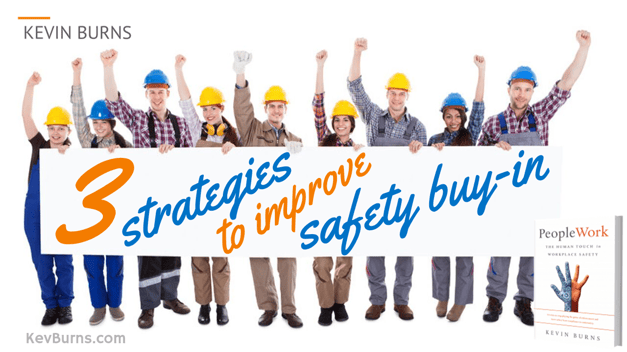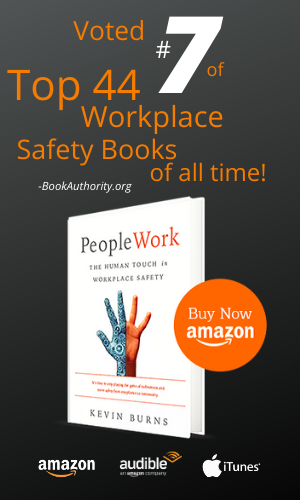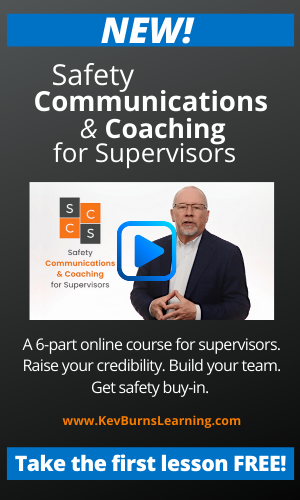3 Strategies to Improve Safety Buy-in
We don’t need more safety rules. We need more buy-in to safety.
 It feels like safety is in a transition place – where the compliance and punitive consequential measures of the past are giving way to more of a sense of community and teamwork. Where rules-based safety programs are giving way to higher levels of engagement, awareness and participation. Where safety managers are acting more in a consultative role instead of the clipboard carrying, looking-over-shoulder types of the past. But there is still resistance to safety by some employees (there is certainly no widespread and universal acceptance of safety) largely due to how safety has been positioned in the workplace.
It feels like safety is in a transition place – where the compliance and punitive consequential measures of the past are giving way to more of a sense of community and teamwork. Where rules-based safety programs are giving way to higher levels of engagement, awareness and participation. Where safety managers are acting more in a consultative role instead of the clipboard carrying, looking-over-shoulder types of the past. But there is still resistance to safety by some employees (there is certainly no widespread and universal acceptance of safety) largely due to how safety has been positioned in the workplace.
We’ve never had better safety processes and procedures than what we have today in our workplaces. But workplace disengagement numbers are still disappointing. Only a third of our people feel actively engaged, satisfied and taking an active interest in the work they do. Two-thirds do not. Based on those numbers, which group do you think is at risk of experiencing a workplace incident more? The one-third who feel actively engaged, satisfied and take an active interest in the work they do? Or the two-thirds who don’t feel connected to their work?
If you are trying to connect people to safety before you are connecting them to their work, you are skipping a step. You cannot effectively communicate with someone who is not engaged in the conversation. But you try anyway. You hold safety meetings where, by the very numbers above, two-thirds of the group in the meetings aren’t fully engaged. No one takes notes or writes anything down in meetings or briefings. No one commits anything to paper. Essentially, you rely on their memory.
People who are not engaged in their work are certainly not going to be engaged in safely doing the very work they’re not engaged in, are they?
So how can the engagement problem get fixed and build better buy-in to safety? You start with ensuring that front-line supervisors have the proper tools and skills to lead their teams. Start by taking the Free Preview of the Safety Communications & Coaching for Supervisors course. 40-minutes of video instruction, summary sheet download PDFs and a companion MP3 audio version to take with you on the go. Determine whether this is the kind of content you'd like your supervisors to be exposed to.
It’s not a safety procedure. It’s the procedure. Period.
 Engagement is a safety problem. And, as written in my blog post, safety is a marketing problem, if employees are not engaged, they’re not paying attention. And when people don’t have their full attention on-task and on their work, they are at risk. Before you can fix the engagement problem and get better employee buy-in to the safety program, you will need to remove the perceived mental barriers.
Engagement is a safety problem. And, as written in my blog post, safety is a marketing problem, if employees are not engaged, they’re not paying attention. And when people don’t have their full attention on-task and on their work, they are at risk. Before you can fix the engagement problem and get better employee buy-in to the safety program, you will need to remove the perceived mental barriers.
Here are three strategies to improve buy-in and engagement.
1. Stop using the word safety in front of the word procedure. It’s not a safety procedure. It’s the procedure. Period. It’s the only way to do it correctly. When you call it a safety procedure, you suggest that there is another way to do the same work – one without all of the extra rules. There is only one acceptable way of doing the work – the right way. No other way is acceptable. So, it’s not a safety procedure. It’s the correct procedure. It’s how your people are supposed to work for the greatest amount of efficiency and least amount of risk.
Safety is not separate. Stop treating it like it is.
2. Eliminate the competition. Not your actual business competitors but eliminate the perceived competition between production and safety in the minds of employees. When the push is on for production, employees feel like production is being measured. That makes it more immediate and they then weigh one against the other. You exacerbate this when (Item 1 above) you preface any phrase with the word safety. There are meetings and there are safety meetings. There are procedures and there are safety procedures. There are inspections and there are safety inspections. Except that there’s not. There are correct procedures, correct ways to do inspections, and meetings that involve the wellbeing of your people. Until Safety and Operations come together to form the “Safe Operations” department, be cognizant of how you are creating a competition between safety and production.
There are procedures and there are safety procedures. Except that there’s not.
3. Look beyond the narrow focus of safety. In other words, don’t create an internal awareness campaign just about safety. Create something that front-desk receptionists, IT guys, and salespeople can get behind. You are not just attempting to change safety culture. You’re changing the corporate culture – one that cares for and looks after its people. How you do business while looking after your people can be your competitive advantage. Can you connect safety with hiring, sales and new business? If not, then you’re treating safety as something separate from the rest of the organization. And you will struggle to get buy-in from employees. Unify the focus. Build culture – not just safety culture. Besides, I don’t know what the difference is between them anyway. Do you?
Safety is not separate. Stop treating it like it is. It’s confusing and where there is confusion, there is disengagement.
-- Take the FREE preview lesson of Kevin's course Safety Communications & Coaching for Supervisors. 40-minutes of video instruction, summary download PDFs and a companion audio MP3 version to take with you on the go. SCCS is an online course to help energize safety, build teamwork, and get employee buy-in.
Take the FREE preview lesson of Kevin's course Safety Communications & Coaching for Supervisors. 40-minutes of video instruction, summary download PDFs and a companion audio MP3 version to take with you on the go. SCCS is an online course to help energize safety, build teamwork, and get employee buy-in.
Kevin Burns, consultant/author, works with smart, caring companies to energize safety culture, build teamwork, and get employee buy-in.
KevBurns Learning is committed to to helping companies improve safety by improving people, through creative learning materials, virtual strategy sessions, safety meeting presentations, and team coaching programs.
In 2020, BookAuthority.org named PeopleWork #7 of The Top 44 Workplace Safety Books of All Time. Buy yourself a copy of PeopleWork: The Human Touch in Workplace Safety and give another as a gift to a colleague.
Subscribe to Kevin's YouTube channel.
Subscribe to Kevin’s Blog.


